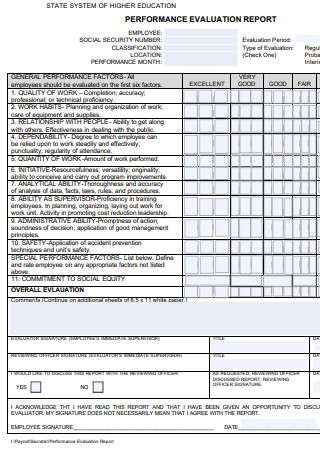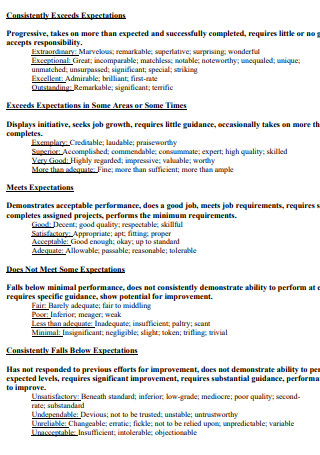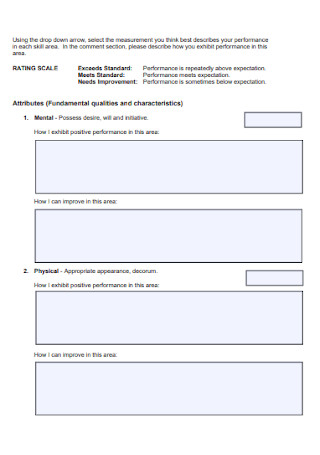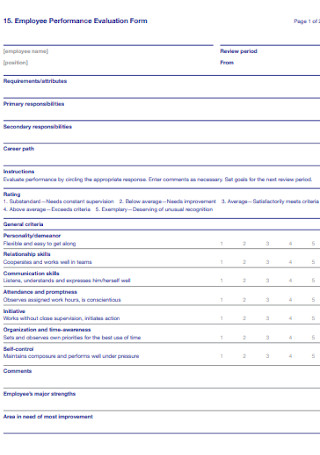5+ Employee Performance Evaluation Reports
FREE Employee Performance Evaluation Report s to Download
5+ Employee Performance Evaluation Reports
What Is an Employee Performance Evaluation Report?
Core Elements Included in an Employee Performance Evaluation
The Different Categories or Skills Measured in an Employee Performance Evaluation
The Different Criteria Rating Used in Performance Evaluation
Step by Step Process in Creating an Employee Performance Evaluation Report
What Is the Purpose of Evaluating the Performance of the Employees?
What Is an Employee Performance Evaluation Report?
This is a formal document that evaluates the performance of the employees at work at a given time based on different categories. This will allow the employers to look into the contribution of the employee in the overall growth, improvement and production of the company as well as the industry. This is an effective instrument to measure the value added by hiring that employee. This can also be called an Employee performance review or in some cases performance appraisal.
Core Elements Included in an Employee Performance Evaluation
The Different Categories or Skills Measured in an Employee Performance Evaluation
Job Knowledge and Skills
This will identify whether the employee has enough knowledge about the position and the scope of work under their job title. Does the employee have the necessary abilities to continuously and consistently perform the tasks that are assigned to him or her?
Quantity of Work
This will identify if the employee has met all the quota required by the supervisor. Is the employee capable of meeting minutes the required deadline for an assigned task?
Quality of Work
It is not enough that an employee is a fast worker. Even if he or she was able to meet the quota and the deadline, it is still important whether they did it with accuracy. Is the employee accurate with the work that they submitted? No matter how fast and how much work they submit, it is important that there are no errors on the document.
Communication Skills
Is the employee capable of communicating with the people in their surroundings? An employee must have good communication skills especially when in the office. This will identify whether they are able to listen to others and they are able to take in what the other people are saying.
Decision-Making Skills
Does the decisions that an employee makes are thought of well? It is important for an employee to be able to make a decision by themselves. This will avoid a halt in the operational plan process and will lead to a higher level of production.
Cooperation Skills
Being independent is not always a good thing especially in the workplace. An employee must be able to work well within a group. This will determine whether a member is a team player or not. This will measure whether an employee comes up with a significant contribution to their respective department for the overall good and achievement of the specified goals.
Reliability
This will determine whether the employee is reliable. Is it possible for the supervisor or manager to depend on that certain employee? Is the employee capable of meeting the roles and responsibilities that are under his or her scope of work and job description?
Attendance
Another factor to evaluate is whether the employee is present at work. Under the attendance records also is their punctuality. This will determine if the employee is always late or are they able to report for work on time.
Flexibility
This will determine whether an employee is able to work under different departments. Are they capable of working at a fast changing pace? Is the employee capable of coping up with the changes that happen in a company or more specifically in the process of different operations.
Coachable
This will determine whether the employee is easy to coach and train. This is also a factor that will affect the performance of the employee. If the employee is easy to train it will lead to a higher level of quantity and quality in their respective work.
The Different Criteria Rating Used in Performance Evaluation
There are different approaches in a criteria rating. Some make use of a numeric approach. On the other hand, some are more comfortable with an alphabetic approach. Nevertheless, both approaches will correspond to an explanation. Here are the different explanations:
The Highest Rating
The code assigned for this is usually number 5 or for the alphabetic it will be equivalent to letter A. This rating means that the employee met all the requirements and consistently showed outstanding performance. This also means that the employee exceeded the expectations of the supervisor.
The Second to the Highest Rating
The numeric code for this will be number 4 or for the alphabetic, it will be equivalent to letter B. This rating means that the employee showed remarkable performance and met all the necessary requirements.
The Average or Middle Rating
The code for this rating will be number 3 and for the alphabetic it will be equivalent to letter C. This rating means that the employee did not meet all the requirements. However, he or she met fragments of the required output. Nevertheless, there is a room for improvement.
The Second to the Lowest Rating
The code that will be used for this rating will be number 2 and for the alphabetic equivalent, it will be letter D. This means that the employee had a poor performance. This usually means that the employee must be monitored and guided accordingly.
The Lowest Rating
The code for this will be number 1 or for the alphabetic, it will be equivalent to letter E. This means that an employee failed on every aspect of the roles and responsibilities assigned to him or her. This will mean that there is an additional training needed for that employee.
Step by Step Process in Creating an Employee Performance Evaluation Report
Step 1: Choose an Evaluation Form
First and foremost, you have to choose a form or a template. This template must be fixed and consistent in order to avoid discrepancy. Set up a standard employee performance evaluation report form. This is the most important step.
Step 2: Identify the Different Performance Categories
The next step is to identify what are the measures that will be used to assess an employee. This will lead to a more objective evaluation. In most cases the performance categories or measure will depend on the job description of an employee. This will allow you to know what needs to be evaluated. It is important to remember that the categories or the measures must be in direct correlation with the job descriptions or the employees scope of work.
Step 3: Identify the Different Criteria Ratings
After identifying the different performance measures, it is time to identify what will be the grading method or the rating method. This will allow you to be accurate and vigilant in evaluating the employees based on the different performance measures.
Step 4: Identify the Guidelines for Feedbacks
As stated in the key elements of an employee performance evaluation, one of the most important things to include in the report are the comments or suggestions. These can also be called feedback Evaluation. It is important to have a standard guidelines for a supervisor or reviewer to know and understand what will be the feedback or how to add in comments and suggestions
The different guidelines may be made up of:
Giving Fair Feedback
This means that the reviewer must not be settled on the mistakes and shortcomings of the employee. Rather, focus more on the good qualities and good things that they have accomplished.
Identify the Expectations
This means that the reviewer must clearly state and explain the expectations on that certain employee. What are the expectations in terms of growth and improvement for that employee. This should be written in a clear and brief manner.
Encouraging Their Point Of View
After the reviewer had evaluated the performance of the employee. It is time to encourage the employee to share his or her point of view regarding the subject matter. The reviewer must be open to the opinion of the employee as well. This will lead to a better understanding as well as a more productive workplace.
Step 5: Identifying the Procedure for Disciplinary Actions
After the evaluation and there are no notable changes or improvement in the part of the employee, it is important to know what the consequences are. Identify the different disciplinary actions on how to discipline the employee. By this the employee will have a motivation to do better.
Documents that may be of help in this step are policy and procedure, warning letter and termination letter.
Step 6: Identify the Schedule
After completing the document and supporting details, it is important to identify when you will be conducting the performance evaluation. It is important to meet the deadlines as well as the starting date and end date of the evaluation period.
What Is the Purpose of Evaluating the Performance of the Employees?
Overall, an employee performance evaluation will greatly help in improving the performance as well as the efficiency of the company. This will lead to a higher level of quality in their work and outputs or products.
In doing a performance appraisal it is better to be honest. However, the reviewer must understand to choose their words carefully and end with a good note. This is done to encourage employees to do better. A performance evaluation must also be done and presented to the employee face to face, this will give the employee a chance to ask questions. This will help to avoid having misunderstanding and miscommunication.
Constant and consistent performance evaluation on the employee will remind and motivate them of what the policy and procedure of the company is. This will also let them have a visual of the future growth of the company as well as the goal statement of the company. Make use of the templates available above in order to effectively evaluate and motivate your employees.






